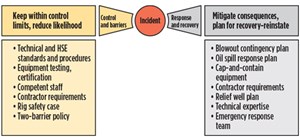Keeping the learning process alive
Process safety is distinct from personal safety. It is concerned with the management of hazards that can give rise to major accidents involving release of potentially dangerous materials; release of energy, such as fire or explosion; or both. It has been more than five years since the Macondo incident triggered many changes in the way that our industry conducts business, and how we approach process safety.
Oil and gas companies have come a long way, in terms of safety efforts to prevent and recover from such a major accident. However, the enduring impression of the incident, and the learnings, can fade through the natural passage of time. We should not let the current business climate of significant cost pressures ever distract us from the fact, that safety must always be advanced as a priority.
One of the most significant lessons from Macondo is that the critical barriers that we have identified must operate independently of each other, also referred to as “defense in depth.” A key question is whether our industry has embedded the learning deeply in our systems and culture, to avoid such incidents in the future.
“Bow tie” approach to risk management. Many operators and contractors have adopted the “bow tie” model as a tool to conduct risk assessments and identify critical barriers. High-quality risk assessments are essential in supporting risk-based decisions needed to manage process safety, and deliver competitive outcomes.
The preventive barriers on the left-hand side of the bow tie include standards for well design and well operations that were improved over the past years. These include enhancement of specification, maintenance and testing of well control equipment, and emphasis on crew competency assurance. The complementary recovery measures on the right-hand side of the bow tie comprise capping and oil spill capabilities, and emergency response training to reduce the risk of escalation. The bow tie model helps to identify the safety-critical equipment and tasks that are relevant to safely execute well activities.
Some examples of Shell’s enhancements consist of the introduction of special training and examination requirements for more experienced staff, and development of advanced well control training for frontline staff. New standards have been introduced for deepwater well design and execution. On equipment, subsea BOP reliability has increased significantly through comprehensive and transparent maintenance programs instituted by drilling contractors and BOP manufacturers. Application of an electronic well control assurance tool (EWCAT) on all offshore drilling units has gained us transparency on compliance with company standards for people’s competence, equipment certification, and performance and barrier verification.
Barrier ownership. Process safety risk management calls for individuals on the front line of operations to take ownership of each barrier that has been allocated to them, including verifying that the barrier is in place and effective.
Shell’s “Think Process Safety” initiative was launched in 2013, to help staff and contractors gain an awareness of the 10 areas that will most directly influence wells’ process safety. We are working with our contractors to ensure that crews in safety-critical roles understand, and own, safety-critical tasks allocated to them, as defined in their bow ties.
Particularly in times of commercial turmoil, we must help each other to keep past learning alive. As an industry, we must recognize that efforts to drive cultural change take time, require resilient leadership focus, and must transcend the boundaries of our companies. They need to span across all parties that work in the oil and gas industry. By doing so, we help to keep each other honest in ensuring that past learning remains alive in our conversations and embedded in our ways of working. ![]()



